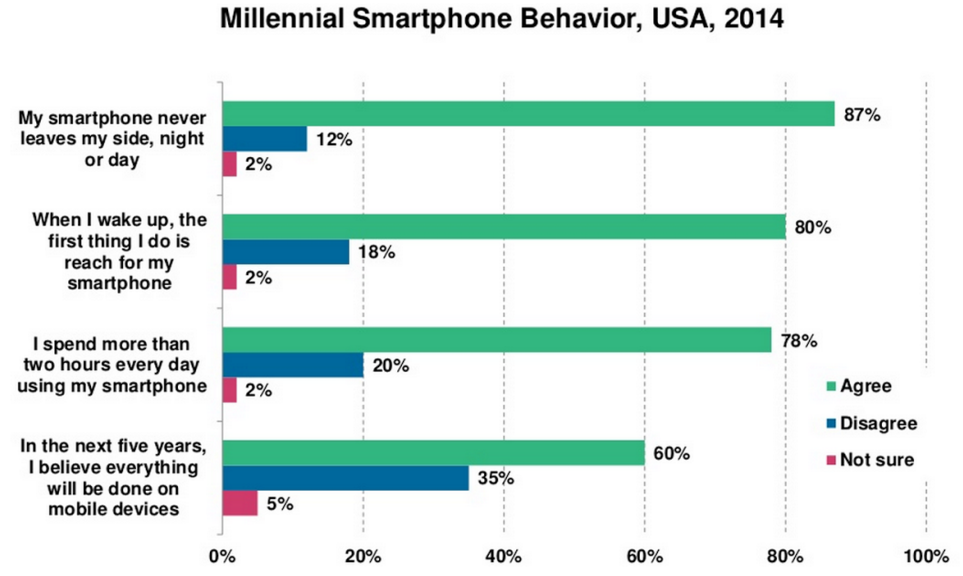Facebook has been making waves in the investment community with it’s massive success in mobile ad revenues. And they are just getting started. According to eMarkter, Facebook’s mobile ad revenue will top $2 billion in 2013, an increase of more than 300% from the less than half a billion dollars earned in 2012.
Unsurprisingly, Mobile developers and marketers were way ahead of Wall Street on this one, and it’s pretty much the biggest secret that everybody knows about right now.
Earlier in 2013, developers started playing with the Facebook mobile app install tools, experimenting with the different options. in the last week of Q1, 40% of the top 100 iOS and Android app developers bought Install ads.
Very quickly, it become clear to mobile acquisition experts that the pendulum in mobile app installs ads has shifted from ad networks to Facebook’s platform. I’ve talked to several marketers and growth professional, mostly in mobile gaming (where a lion’s share of the spending is happening today), and they are all basically saying the same thing – Facebook has the best ROI in the market right now. Most of them are spending at least 50% of our budget on Facebook, and some spend much more.
So why is Facebook is winning in mobile app installs?
First and all, the ad-unit itself seems to work well. The bigger picture in the ad does a good job, and the way the ad unit is integrated into the Newsfeed is effective. With current inventory fill rates, it seems that most users get one or two ads as they scroll through their mobile Newsfeed. That seems like an acceptable ad saturation rate for most users, resulting in less ad fatigue and better conversion rates for advertisers.
More importantly, Facebook has been able to do much more with targeting than most mobile ad networks out there have been able to do so far. Mobile Ad networks are facing  technical barriers, driven by the constraints of the iOS and Android platform. With lack of robust tracking tools across apps, like pixels on the web, It’s difficult for ad networks to track users across apps and gather all the data they need. This results in smaller buckets of available targeted audience. For example, if a marketer is looking for a demographic of woman aged 34-45 interested in event planning, ad networks might provide some or all of the demographics and interest based targeting, but it’s virtually impossible to find an ad network that can deliver the ad to a significant audience scale like Facebook does.
Facebook has also rounded up the it’s mobile ad platform with a number of goodies. One robust capability is the “Look a like audience” feature, which is basically a shortcut to leverage 1st party proprietary data. It enables a marketer to target ads to users who have “Look a like” interests compared to the Facebook fan page userbase. It also allows marketers to retarget customers in the app through contact information, such as email addresses and phone numbers. This is a breakthrough for many marketers who have troves of data,  but are having difficulties leveraging the data to have better targeting.
All this stuff adds up to a substantial advantage driving real value for app developers. Is this advantage sustainable?
For mobile Ad Networks it might be challenging to build an audience as wide and deep as Facebook has, without getting more flexibility from the platforms with tracking and data. Many marketers speculate that this might not happen on iOS at all (Apple seems to be taking the opposite route by tightening control over user data and removing UDID). Some think that there might be more flexibility on Google’s Android platform, but it remains an open question.
Google probably has its sight on the app install ad spending, and could use the Android platform data to build similar capabilities and go direct to market. With Facebook’s success, it’s almost eminent in my mind. It makes sense for Google to try to play the Mobile app install game – both on Google+ and through other mobile properties, as well as power other types of ads across Android apps. Â Apple with iAd is trying to do the same, but up until now Cupertino has not shown marketers that the ad platform is effective, and they need to up it’s game to get there.
All in all, it seems that Facebook has a winner for the short term, and maybe also for the long term.





